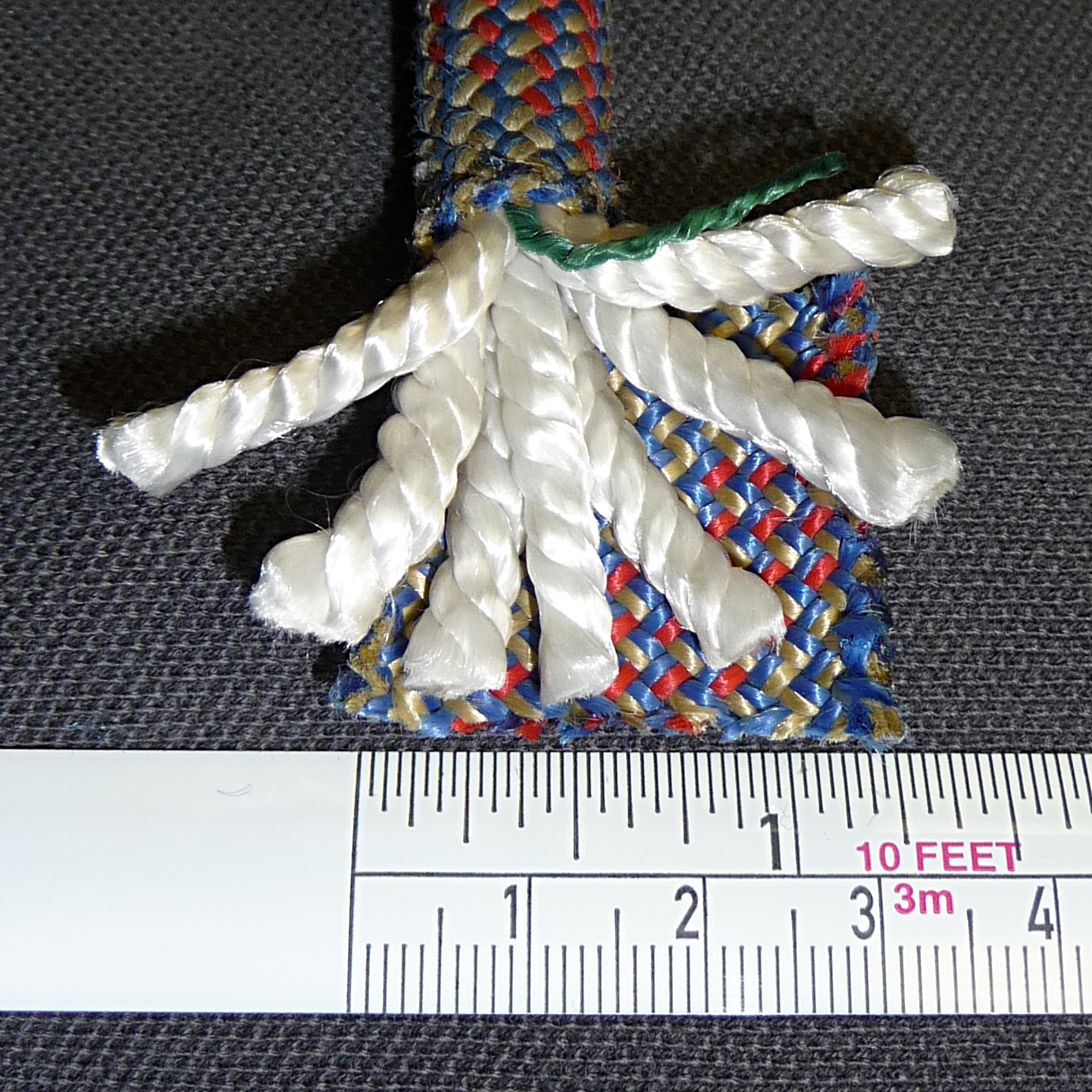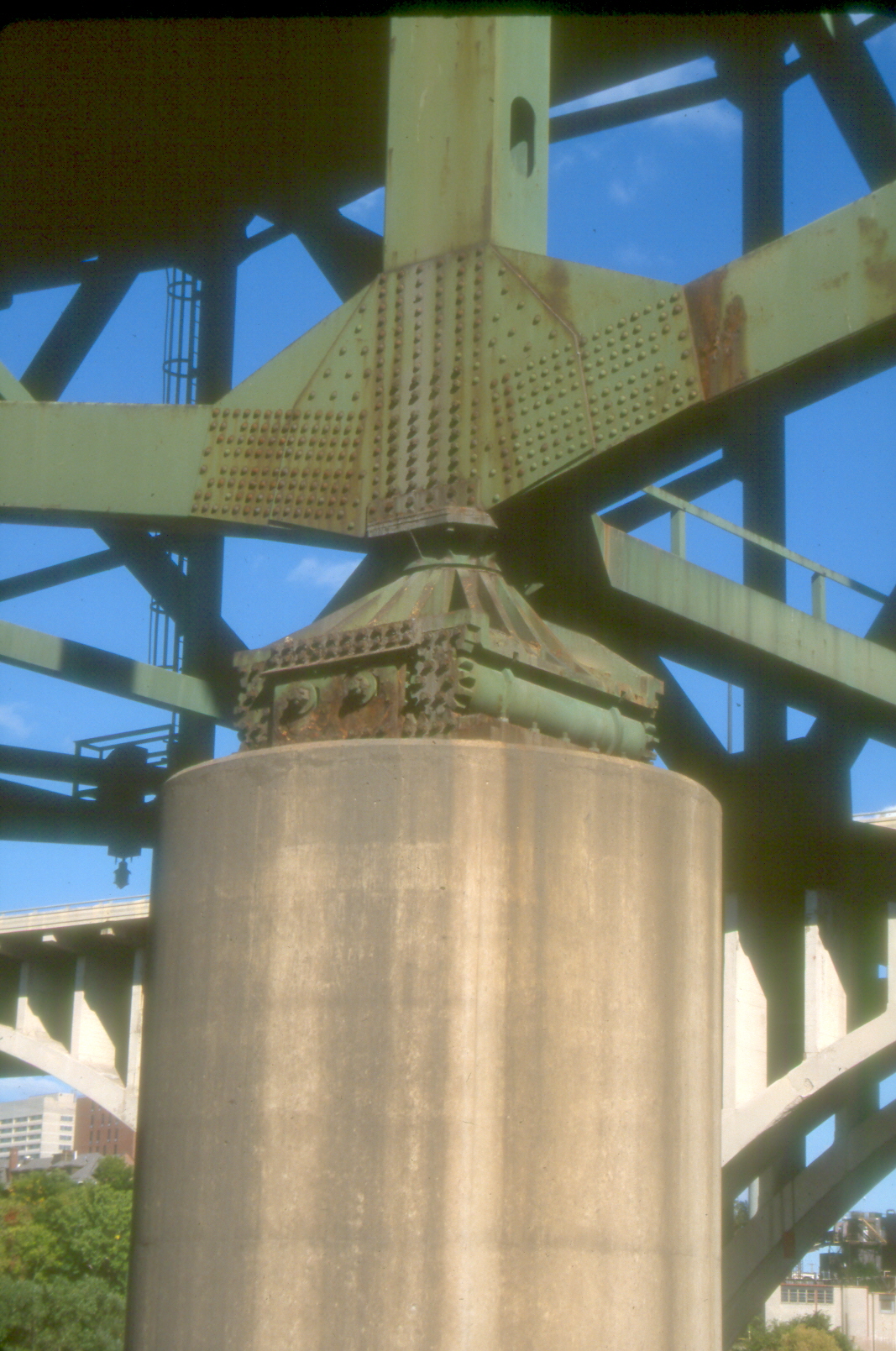|
Spanish Web
The Spanish web is an aerial circus skill in which a performer climbs and performs various tricks on an apparatus resembling a vertically hanging rope. It is similar in appearance and performance style to the corde lisse, but with the addition of loops on the rope for hands or feet, permitting one to perform a variety of spinning motions. The name refers to both the apparatus and the performance. Rope structure The apparatus is akin to a larger kernmantle rope. Unbraided cotton or polyster-blend rope is pulled through a soft, round, cotton sleeve two inches in diameter (a "web"). An eye is made in one end of the web, to which a swivel is attached. That is suspended at one end from the overhead rigging. Towards the top of the web, a hand, foot or neck loop is attached to the main rope through which a performer will secure an ankle, wrist or their neck and be able to hang freely while spinning. Performance In a typical Spanish web performance, there is a climber (or flyer) and a we ... [...More Info...] [...Related Items...] OR: [Wikipedia] [Google] [Baidu] |
Circus Skill
Circus skills are a group of disciplines that have been performed as entertainment in circus, sideshow, busking, or variety, vaudeville, or music hall shows. Most circus skills are still being performed today. Many are also practiced by non-performers as a hobby. Circus schools and instructors use various systems of categorization to group circus skills by type. Systems that have attempted to formally organize circus skills into pragmatic teaching groupings include the Gurevich system"The Classification of Circus Techniques" by Hovey Burgess. ''The Drama Review'': TDR, Vol. 18, No. 1, Popular Entertainments (Mar., 1974), pp. 65-70. doi:10.2307/1144863. (the basis of the Russian Circus School's curriculum) and the Hovey Burgess system. Circus skills * Acrobalance * Acrobatics * Acro dance * Adagio * Aerial hoop * Aerial silk * Aerial straps * Artistic cycling * Balancing * Banquine * Baton twirling * Buffoonery * Bullwhip * Bungee trapeze * Cannonball catching * Carniv ... [...More Info...] [...Related Items...] OR: [Wikipedia] [Google] [Baidu] |
Corde Lisse
Corde lisse is an aerial circus skill or act that involves acrobatics on a vertically hanging rope. The name is French for "smooth rope". In English-speaking parts of the world, it is also referred to as "aerial rope". Description ''Corde lisse'' moves are normally a combination of held postures and drops using a rope that hangs from the ceiling. These ropes are normally made from soft cotton about 30-35mm thick. The technique is closely related to both silks, (another aerial circus skill performed on one or two long strips of strong fabric, often in bright colours), and Spanish web. It requires great skill and strength. Performers do not have any kind of safety net or safety line, relying on their own strength and ability to prevent a fall. It is possible for two (or more) people to perform on the same rope, although more than two is rare. The performers can hang off each other or be at different heights on the rope. The most famous use of aerial circus skills such as these ... [...More Info...] [...Related Items...] OR: [Wikipedia] [Google] [Baidu] |
Kernmantle Rope
Kernmantle rope () is rope constructed with its interior core protected by a woven exterior sheath designed to optimize strength, durability, and flexibility. The core fibers provide the tensile strength of the rope, while the sheath protects the core from abrasion during use. This is the only construction of rope that is considered to be life safety rope by most fire and rescue services. Parachute cord Parachute cord (also paracord or 550 cord when referring to type-III paracord) is a lightweight nylon kernmantle rope originally used in the suspension lines of parachutes. This cord is useful for many other tasks and is now used as a general purpose utility cord by both military personnel and civilians. Use as climbing rope One of the uses of kernmantle rope is as climbing rope. Nylon ropes that were used in yachts for hauling were tested and found useful in climbing and caving and are now the modern standard. The German company Edelrid introduced the first kernmantel rope ... [...More Info...] [...Related Items...] OR: [Wikipedia] [Google] [Baidu] |
Webbing
red, blue and black auto_racing.html"_;"title="nylon_webbing_as_used_in_auto_racing">nylon_webbing_as_used_in_auto_racing_harnesses Webbing_is_a_strong_nylon_webbing_as_used_in_auto_racing_harnesses">auto_racing.html"_;"title="nylon_webbing_as_used_in_auto_racing">nylon_webbing_as_used_in_auto_racing_harnesses Webbing_is_a_strong_Textile">fabric_weaving.html" "title="Textile.html" "title="auto_racing_harnesses.html" ;"title="auto_racing.html" ;"title="nylon webbing as used in auto racing">nylon webbing as used in auto racing harnesses">auto_racing.html" ;"title="nylon webbing as used in auto racing">nylon webbing as used in auto racing harnesses Webbing is a strong Textile">fabric weaving">woven as a flat strip or tube of varying width and fibres, often used in place of rope. It is a versatile component used in climbing, slacklining, furniture manufacturing, automobile safety, auto racing, tow truck, towing, parachuting, military apparel, load securing, and many other fiel ... [...More Info...] [...Related Items...] OR: [Wikipedia] [Google] [Baidu] |
Aerial Rigging
Aerial rigging is a specialty within the field of rigging that deals specifically with human loads. Aerial rigging is the process of setting up equipment used to make humans fly, specifically aerial circus and aerial dance equipment. The field is of critical importance, and a thorough grasp of the principles of aerial rigging is essential in order to ensure the safety of the artists and the audience. Aerial rigging is commonly practiced to different degrees by specialty fabricators, professional riggers, professional aerial artists, as well as amateur aerial artists. Most aerial circus equipment is built by fabricators around the world that build equipment specifically for the circus industry. Aerial artists, both professional and amateur, often become riggers out of necessity. They generally learn to rig what they need. WLA (Weak Link Analysis) is the process of systematically analyzing aerial rigging for the weakest link or links in the system. WLA is the most common process ... [...More Info...] [...Related Items...] OR: [Wikipedia] [Google] [Baidu] |
Centrifugal Force
In Newtonian mechanics, the centrifugal force is an inertial force (also called a "fictitious" or "pseudo" force) that appears to act on all objects when viewed in a rotating frame of reference. It is directed away from an axis which is parallel to the axis of rotation and passing through the coordinate system's origin. If the axis of rotation passes through the coordinate system's origin, the centrifugal force is directed radially outwards from that axis. The magnitude of centrifugal force ''F'' on an object of mass ''m'' at the distance ''r'' from the origin of a frame of reference rotating with angular velocity is: F = m\omega^2 r The concept of centrifugal force can be applied in rotating devices, such as centrifuges, centrifugal pumps, centrifugal governors, and centrifugal clutches, and in centrifugal railways, planetary orbits and banked curves, when they are analyzed in a rotating coordinate system. Confusingly, the term has sometimes also been used for the reactiv ... [...More Info...] [...Related Items...] OR: [Wikipedia] [Google] [Baidu] |
Guy Line
A guy-wire, guy-line, guy-rope, or stay, also called simply a guy, is a tensioned cable designed to add stability to a free-standing structure. They are used commonly for ship masts, radio masts, wind turbines, utility poles, and tents. A thin vertical mast supported by guy wires is called a guyed mast. Structures that support antennas are frequently of a lattice construction and are called "towers". One end of the guy is attached to the structure, and the other is anchored to the ground at some distance from the mast or tower base. The tension in the diagonal guy-wire, combined with the compression and buckling strength of the structure, allows the structure to withstand lateral loads such as wind or the weight of cantilevered structures. They are installed radially, usually at equal angles about the structure, in trios and quads. As the tower leans a bit due to the wind force, the increased guy tension is resolved into a compression force in the tower or mast and a late ... [...More Info...] [...Related Items...] OR: [Wikipedia] [Google] [Baidu] |
Gusset Plate
Gusset plate is a plate for connecting beams and girders to columns. A gusset plate can be fastened to a permanent member either by bolts, rivets or welding or a combination of the three. They are used in bridges and buildings, as well as other structures. Materials Gusset plates are usually either made from cold-rolled or galvanized steel, based upon their use. Galvanized steel offers more protection from rust, so this is usually used when the gusset plate is exposed to the elements. The gusset plate is usually painted to match nearby steel and fixtures and to give it an extra layer of protection. Occasionally gusset plates are made from copper or aluminum, but only with small structures that do not require much support. The copper and aluminum gusset plates also provide a more attractive finish for exposed structures. Uses Gusset plates are used for various structures. Gusset plates are used to connect beams and columns together or to connect truss members. They can be ei ... [...More Info...] [...Related Items...] OR: [Wikipedia] [Google] [Baidu] |
Corde Lisse
Corde lisse is an aerial circus skill or act that involves acrobatics on a vertically hanging rope. The name is French for "smooth rope". In English-speaking parts of the world, it is also referred to as "aerial rope". Description ''Corde lisse'' moves are normally a combination of held postures and drops using a rope that hangs from the ceiling. These ropes are normally made from soft cotton about 30-35mm thick. The technique is closely related to both silks, (another aerial circus skill performed on one or two long strips of strong fabric, often in bright colours), and Spanish web. It requires great skill and strength. Performers do not have any kind of safety net or safety line, relying on their own strength and ability to prevent a fall. It is possible for two (or more) people to perform on the same rope, although more than two is rare. The performers can hang off each other or be at different heights on the rope. The most famous use of aerial circus skills such as these ... [...More Info...] [...Related Items...] OR: [Wikipedia] [Google] [Baidu] |
Aerial Silk
Aerial silks (also known as aerial contortion, aerial ribbons, aerial tissues, fabric, ribbon, or ''tissu'') is a type of performance in which one or more artists perform aerial acrobatics while hanging from a specialist fabric. The fabric may be hung as two pieces, or a single piece, folded to make a loop, classified as hammock silks. Performers climb the suspended fabric without the use of safety lines and rely only on their training and skill to ensure safety. They use the fabric to wrap, suspend, drop, swing, and spiral their bodies into and out of various positions. The fabric may also be used to fly through the air, striking poses and figures. Some performers use rosin (dried or mixed with rubbing alcohol) on their hands and feet to increase the friction and grip on the fabric. Aerial silks is a demanding art and requires a high degree of strength, power, flexibility, courage, stamina, and grace to practice. Tricks The three main categories of tricks are climbs, wraps, a ... [...More Info...] [...Related Items...] OR: [Wikipedia] [Google] [Baidu] |





